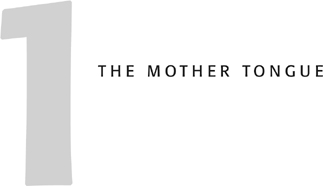Where did language start in the first place? It must have been long before there were humans. Imagine primitive ape-creatures huddled together in a cave; they’d have to communicate somehow. They’d want some way to say, Give that back, it’s mine! or Move over, you’re standing on my foot! And the more they lived together, the more they’d need to say. Where’d you find those blueberries? Chase that rabbit over here and I’ll grab it. As they evolved into humans, and learned farming and other skills, their language would become more complicated: I’ll trade you half my honey next week for one of those catfish today.
While early humans were developing languages, they were also migrating from place to place. Sometimes they were driven by changes in the weather, or by natural disasters like floods and forest fires. Sometimes they were moving away from hostile neighbors, or following the animals they hunted. For many reasons, groups of people were leaving one home territory and looking for another.
By comparing certain languages and tracing their roots, finding similar words that seem to come from the same ancient, mysterious source, scholars have concluded that in the far distant past – maybe six or eight thousand years ago – some people were speaking a language that has now been lost. They had no writing (that we’ve found) so we have no records, and we know very little about who they were, or where and how they lived. They seem to have had words for snow and wolf but not for ocean, so their homeland was probably cold and far from the sea – likely somewhere in Central Europe. But that’s about all we can say. That, and one other thing: for some reason, small bands of these people migrated in different directions. They carried their language across Europe and Asia and even up into Scandinavia.
Once their communities became separated, their ways of speaking slowly began to differ, creating a whole family of languages that we describe as Indo-European. One version, Celtic Indo-European, is the source of modern Welsh, and of the Gaelic spoken in Ireland and Scotland. Farther south, Greek Indo-European developed into ancient and then modern Greek. The Indo-Iranian form is the foundation of most languages of India, Pakistan, and Iran. Italic Indo-European gave rise to Latin, which gave rise to Italian, French, and Spanish. The Slavic version is the basis of Russian, Bulgarian, and Polish. Germanic Indo-European is the root of Dutch, most Scandinavian languages, German and Yiddish – and English. And these are only a few examples. Altogether, the roots of the languages spoken by about half the people in today’s world reach back to the Indo-European tongue of those unknown people so long ago.
How much Sanskrit is hiding in your kitchen? The ancient Hindus cooked with pippali (berry), sarkara (grit), and crngaveram (powdered horn-body, an antler-shaped root). The Greeks called these seasonings peperi, sakkharon, and ziggiberis. We know them as pepper, sugar, and ginger. (Do you see where the artificial sweetener saccharin gets its name?)
One of the earliest Indo-European languages that we have in written form is Sanskrit. In India, Hindu scriptures called the Veda were written in Sanskrit about 3,500 years ago. (Veda is Sanskrit for “knowledge.”) Sanskrit was the language of India’s court and literature 2,500 years ago, and although it’s not used in daily speech any more, it’s still part of Hindu religious ceremonies.
Although modern Indo-European languages have been developing separately for thousands of years, and now seem very different from one another, it’s intriguing to track down the similarities. For example, the Sanskrit words for one, two, three, are pronounced eka, dvi, tri. Compare those ancient words to these:

And look at the “family tree” for this word:

Sanskrit and its descendants – such as Latin, Ancient Greek, and early French and Germanic languages – gave English more than just vocabulary. They also left fragments of their grammar, ghosts that lurk behind our sentences like scraps of faded photos in a family album. These odds and ends can be puzzling, even frustrating, but they deserve respect. They come from the dawn of the English language, and long before.

One of the greatest Hindu gods, Shiva (SHEE-vah), appears in Sanskrit texts over two thousand years old. Shiva can take various forms, some kind, some cruel and dreadful. Here he appears as the four-armed Lord of the Dance, surrounded by a fiery halo representing the cycle of creation, destruction, and rebirth, and trampling a demon to symbolize the end of evil.
